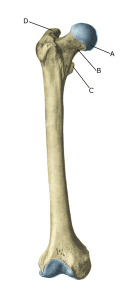Anatomy

A. Caput femoris
B. Collum femoris
C. Trochanter minor
D. Trochanter major
Cause
Femur fractures are rare in children and adolescents and usually occur after a strong blow or twist. Most fractures occur in the middle part of the femur or in the lower (distal) growth zone.
Symptoms
Sudden onset of severe pain in the thigh. It will usually be impossible to support the leg due to pain. There may be soft tissue swelling and possibly malalignment.
Examination
Suspected fractures of the femur require urgent medical examination (possibly in hospital). Femur fractures can usually be seen on X-ray in 2 projections.
Treatment
Treatment is entirely dependent on the severity of the fracture and any malalignment. Therefore, rehabilitation should be done in close co-operation with the doctors responsible for the treatment. Age affects the choice of treatment, which can include bracing, taping and surgery (Muhammad H, et al. 2022).
Rehabilitation, specific
The load and rehabilitation that can be allowed is entirely dependent on the severity and treatment of the fracture, which is why all rehabilitation should be carried out in close co-operation with the doctors supervising the treatment. It usually takes at least a few months before sports activity can be resumed.
Complications
The vast majority of cases heal without complications and without harm after both non-operative and operative treatment. Complication rates include bone shortening, growth problems, infections and healing problems where a false joint can form (pseudoarthrosis).
